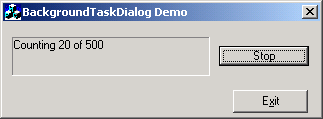
Introduction
Hi, my name is Mauro H. Leggieri, a Windows and Game programmer. I made a little thing that may be useful, and want to share with you.
I wrote a class named CBackgroundTaskDialog derived from the standard CDialog class. It is a wrapper for dialog boxes where you must do a long-time process, optionally showing the progress information, but you don't want your application to appear to be hung.
Using the code
The code simply creates a background thread and calls some member functions where you write your own code and have some members to control when to start/stop the background process.
To use the code in your project, first add the BackgroundTaskDialog.cpp and BackgroundTaskDialog.h files to your project.
Then, in the header file of the dialog you want to subclass, add the include "BackgroundTaskDialog.h" statement and replace all CDialog words with CBackgroundTaskDialog and add the following member declarations to the class:
class your_dialog_class : public CBackgroundTaskDialog
{
public:
void RunBackgroundTask();
}
After this, replace in the CPP file of the dialog all CDialog words with CBackgroundTaskDialog too and add the following members code:
void your_dialog_class_name::RunBackgroundTask()
{
}
To start the background process, you must use the StartBackgroundTask function. It returns a value of 1 if all is ok or less than 0 if an error occurs. The function is usually used in the OnInitDialog function.
BOOL your_dialog_class_name::OnInitDialog()
{
if (StartBackgroundTask() < 0)
{
AfxMessageBox(_T("Error"));
PostMessage(WM_CLOSE, 0, 0);
return TRUE;
}
return TRUE;
}
At last, if you want to abort the background process, call the StopBackgroundTask function.
See the example project because it has more explanations.
My name is Mauro Leggieri. I am 30 year-old, married and have a child.
I am a system engineer (UTN university) and am being programming for more than 20 years from the C64 to the PC and some microcontrollers.
Mostly of my time, I program games for Windows.
Soon, my site http://www.mauroleggieri.com.ar
 General
General  News
News  Suggestion
Suggestion  Question
Question  Bug
Bug  Answer
Answer  Joke
Joke  Praise
Praise  Rant
Rant  Admin
Admin 








 Perfect.
Perfect.